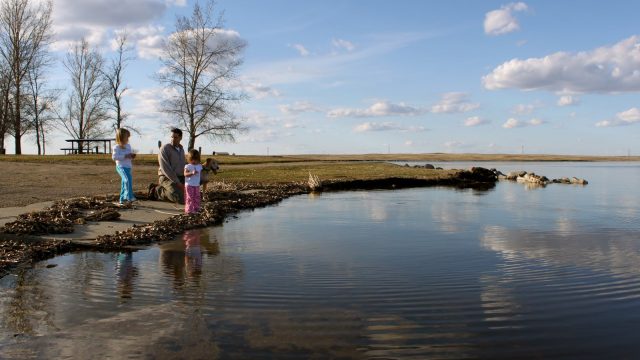Doug Leier: Good North Dakota Fishing Is Here To Stay

The well documented and discussed wet cycle and expansion of fisheries is not new to most anglers, or even people who don’t fish. Anyone over the age of 25 can attest to the continuing growth and expansion of water and fisheries in North Dakota.
While the slow accumulation of new water on the landscape has created new fisheries through natural connections and drainages, North Dakota Game and Fish biologists have contributed in many ways to develop fish populations and provide access to new those new waters.
Fisheries production and development supervisor Jerry Weigel said 20 years ago Game and Fish stocked approximately 50-70 waters annually with walleye fingerlings. That number grew to about 100 in the early 2000s.
This year, 156 waters shared 9 million walleye fingerlings. “The growth in walleye waters is directly correlated to the number of public fishing waters we manage,” Weigel said.
In 1988, Game and Fish managed 160 public fishing waters totaling 99,098 acres, not including the Missouri River System. Today, Weigel said the department manages 415 waters and 345,988 acres, excluding the Missouri River System.
“This has put a lot of pressure on the two federal hatcheries in the state, Garrison Dam and Valley City,” Weigel added. “We need every available pond to meet a 9 million walleye fingerling request. In the last four years we have stocked more than 38 million walleyes in the state, in addition to salmon, trout, pike, bass and panfish.”
Weigel said the flood of 2011 caused the 40 east unit hatchery ponds at the Garrison Dam hatchery to lose their water supply. In order to fill the 40 1.5-acre ponds, he said Game and Fish had to rent pumps in 2012 and 2013. The department recently completed a permanent fix at a cost of $500,000, thus eliminating the need to rent pumps in the future.
To help offset the reduced role the U.S. Fish and Wildlife Service has with recreational fish production in recent years, Game and Fish provides seasonal staffing at both hatcheries and pays for half the operational costs at Garrison Dam. According to Weigel, this is in addition to both collecting all the eggs each spring and transporting all fish from both hatcheries.
“There is no question the hatcheries play a vital role in the growth of the state’s fisheries and will continue to be needed to sustain this growth,” Weigel added. “The federal hatchery staff strives to operate at 100 percent efficiency, and thankfully that has been the case. Even at that, there is growing demand, thus Game and Fish has increased its assistance when possible.”
Fisheries biologists will be the first to point out that without adequate habitat – good water quality, depth and associated structure – stocking efforts would not sustain a long-term fishery.
And again, it’s not just stocking that is responsible for these many new lakes coming on line. In many cases, natural reproduction has done what stocking never could.
Together, Mother Nature and fisheries management efforts have led to the best fishing our state and anglers have ever enjoyed.
And the scary thing is, it may not have peaked yet. Time will tell, but this era of good fishing pretty much statewide could last for a long time.




